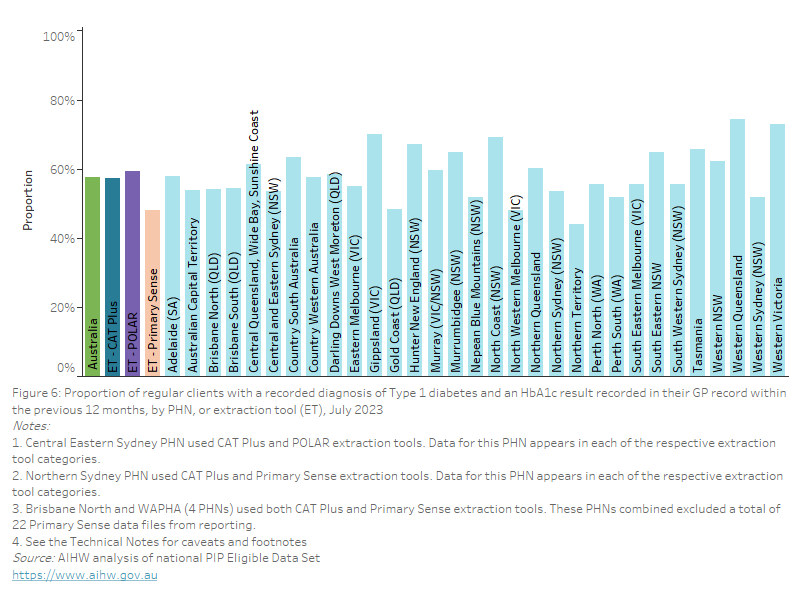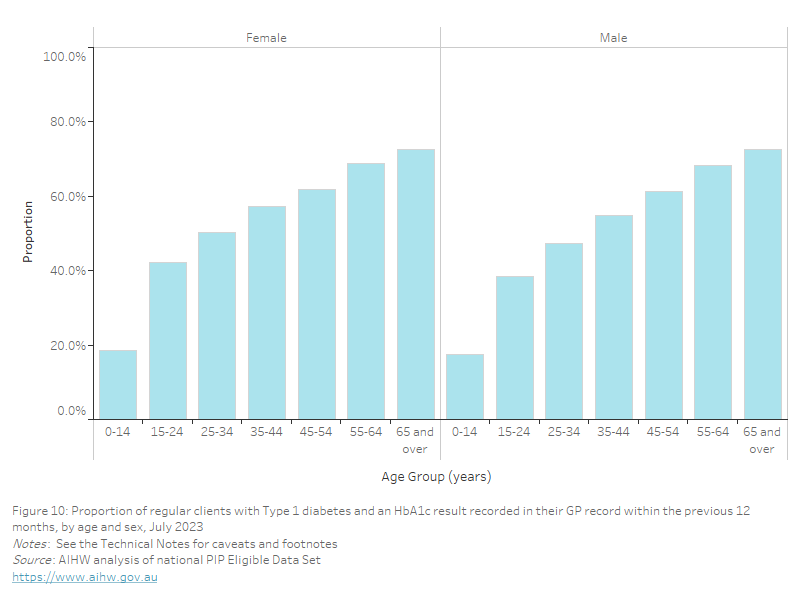QIM 5: Proportion of regular clients with diabetes with an influenza immunisation status recorded in their GP record within the previous 15 months
On this page:
Overview
Regional proportions
National proportions over time
National proportions by age and sex
Overview
Influenza is a common disease of the respiratory tract. It affects people of all ages. It is estimated that influenza is likely to be associated with more than 3,000 deaths and 13,500 hospitalisations each year in Australia, just in people aged >50 years (NCIRS 2021).
There are a number of groups who are at a higher risk of influenza and its complications. These groups experience higher illness and death associated with influenza than the rest of the population and patients with diabetes is one of the vulnerable population groups. Therefore, annual influenza vaccination is strongly recommended for patients with diabetes (ATAGI 2023).
While best practice guidelines recommend annual immunisation, a 15-month interval allows for cases when a client decides to receive a vaccine earlier than recommended (for example, from a pharmacy), or delay and wait for the release of an ‘enhanced’ vaccine (Department of Health 2020b).
Capture of results recorded outside of the general practice setting
Some patients may receive care from other practitioners in addition to a GP, including an endocrinologist/a specialist physician, and/or other health care providers to safely manage their diabetes (RACGP 2020d). Results arising from clinical intervention conducted outside of the service that are known and recorded by the practice are included in the measure. Where immunisation was provided elsewhere but is not known to the practice, this is not captured in the report. For example, this might be where the vaccination providers’ information systems may not be compatible with the clinical information system (CISs) of the client’s usual general practice.
Other sources of relevant data
Data on the prevalence of long-term health conditions like diabetes are captured in the National Health Survey (NHS) conducted by the Australian Bureau of Statistics (ABS). There are other administrative data collections where the data from these client-provider interactions are captured, for example, Medicare Benefits Schedule (MBS), the National Diabetes Service Scheme (NDSS) register and the Australasian Paediatric Endocrine Groups (APEG) state and territory registers. There are other administrative data collections where data on influenza immunisation are captured, for example, the Australian Immunisation Register (AIR).
This indicator reports on the proportion of regular clients with Type 1 or Type 2 diabetes, or an undefined diabetes diagnosis, hereafter described as diabetes, who had an influenza immunisation status recorded in their GP record within the previous 15 months.
The QIM proportions summarised by the different extraction tools in use are also shown in the ‘Regional proportions’ bar charts for this measure. This illustrates the differences in how software providers have interpreted the technical specifications and coding of QIMs.
QIM 5: Regional proportions
As of July 2023, nationally, 51.9% of regular clients with diabetes had an influenza immunisation status recorded in their GP record within the previous 15 months. This varied from 33.1% to 63.2% across PHNs, and between 51.1% and 55.3% across extraction tools.
Figure 38: Proportion of regular clients with diabetes (Type 1, Type 2, undefined) and an influenza immunisation status recorded in their GP record within the previous 15 months, by PHN, or extraction tool (ET), July 2023
This bar chart shows the proportion of regular clients with diabetes (Type 1, Type 2 and undefined) and an influenza immunisation status recorded in their GP record within the previous 15 months, by PHN and extraction tool, for July 2023.

QIM 5: National proportions over time
Nationally, between January 2023 and July 2023, the proportion of regular clients with Type 1 or Type 2 diabetes, or an undefined diabetes diagnosis, who had an influenza immunisation status recorded in their GP record within the previous 15 months increased by 6.1 percentage points, from 45.8% to 51.9%. This increase is due to seasonal factors and is consistent with observations in the 2021-22 national report.
Figure 39: Proportion of regular clients with diabetes (Type 1, Type 2, undefined) and an influenza immunisation status recorded in their GP record within the previous 15 months, January 2023 to July 2023
This line chart shows the proportion of regular clients with diabetes (Type 1, Type 2 and undefined) and an influenza immunisation status recorded in their GP record within the previous 15 months, from January 2023 to July 2023
%3dQIM5+-+IMMUNISED&embed_code_version=3&tabs=no&toolbar=no&showAppBanner=false)
QIM 5: National proportions by age and sex
As of July 2023, nationally, the proportion of regular clients with Type 1 or Type 2 diabetes, or an undefined diabetes diagnosis, who had an influenza immunisation status recorded in their GP record within the previous 15 months was:
- highest in the 65 years and over age group for both females (67.2%) and males (66.6%)
- lowest in the 25–34 years age group for both females (22.4%) and males (17.1%).
Figure 40: Proportion of regular clients with diabetes (Type 1, Type 2, undefined) and an influenza immunisation status recorded in their GP record within the previous 15 months, by age and sex, July 2023
This bar chart shows the proportion of regular clients with diabetes (Type 1, Type 2 and undefined) and an influenza immunisation status recorded in their GP record within the previous 15 months, by age and sex for July 2023

- Data for clients with diabetes are included if they have received an influenza vaccine within the previous 15 months.
- Clinical definitions for diabetes vary across CISs, as different coding schemes are used. This may lead to some variation in the number of clients who will be picked up by different systems (AIHW 2023f).
- Results arising from clinical intervention conducted outside of the service that are known and recorded by the service are included in the measure. Where immunisation was given elsewhere (for example, workplace or pharmacy) and the information is not recorded in the electronic record of the client’s usual general practice, then this may result in an apparent missing information.
- A client is classified as having diabetes, if they have Type 1 or Type 2 diabetes, or a diagnosis which indicates diabetes but does not specify between Type 1 or Type 2, listed as a diagnosis in their GP record. If a client had gestational diabetes but also has Type 1 or Type 2 diabetes, they are included in the measure.
- Clients are excluded from the measure if they:
- did not have the immunisation due to documented medical reasons (e.g. allergy), system reasons (vaccine not available) or client reasons (e.g. refusal),
- had secondary diabetes, gestational diabetes mellitus (GDM), previous GDM, impaired fasting glucose, impaired glucose tolerance,
- had results from measurements conducted outside of the service which were not available to the service.
- There are other administrative data collections where the data on influenza immunisation are captured for example, the Australian Immunisation Register (AIR).
AIHW (Australian Institute of Health and Welfare) (2023f) First Nations-specific primary health care: results from the nKPI and OSR collections, AIHW, Canberra, accessed 03 August 2023.
ATAGI (Australian Technical Advisory Group on Immunisation) (2023) Australian Immunisation Handbook, Department of Health, Canberra, accessed 10 July 2023.
Department of Health (2020b) Practice Incentives Program Quality Improvement Measures User Guide for Primary Health Networks, Department of Health, Canberra, accessed 6 July 2023.
NCIRS (National Centre for Immunisation Research and Surveillance) (2021) Influenza vaccines for Australians - Fact Sheet, NCIRS, Sydney, accessed 12 July 2023.
RACGP (The Royal Australian College of General Practitioners) (2020d) Management of type 2 diabetes: A handbook for general practice, RACGP, East Melbourne, Victoria, accessed 2 August 2023.


